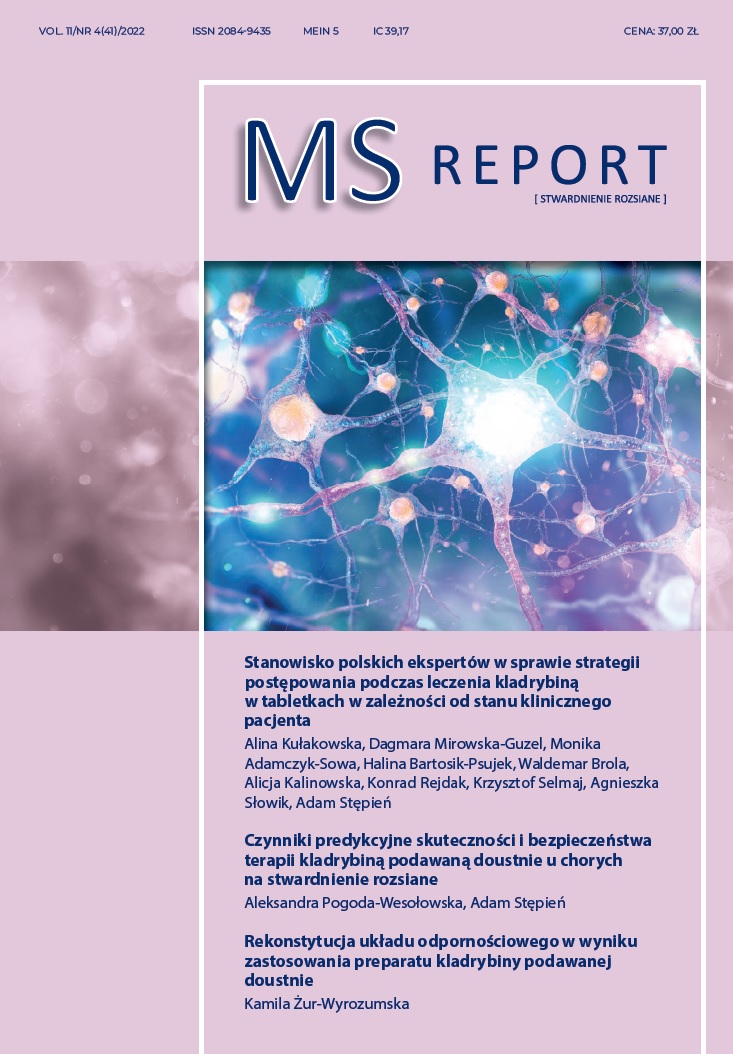Czynniki predykcyjne skuteczności i bezpieczeństwa terapii kladrybiną podawaną doustnie u chorych na stwardnienie rozsiane Artykuł przeglądowy
##plugins.themes.bootstrap3.article.main##
Abstrakt
Obecnie najbardziej pożądanym scenariuszem w leczeniu stwardnienia rozsianego jest osiągnięcie stanu „braku dowodów aktywności choroby”, czyli wskaźnika NEDA. W praktyce klinicznej prowadzi to do szybszej eskalacji leczenia lub wczesnego wdrożenia wysoce aktywnych terapii jako pierwszego rzutu. Aktualne zalecenia ekspertów ECTRIMS rekomendują stosowanie terapii modyfikującej przebieg choroby o większej aktywności takich jak doustna kladrybina (CladT) we wcześniejszych jej stadiach. Potwierdzona długoterminowa skuteczność CladT wynika m.in. z odpowiednio dobranego profilu pacjenta. Pełny kurs leczenia doustną kladrybiną u większości chorych nie wymaga stosowania kolejnych terapii przez co najmniej 4 lata. Tym bardziej niezwykle ważna staje się identyfikacja czynników predykcyjnych, które pozwolą przewidzieć pozytywną i długotrwałą odpowiedź na leczenie CladT.
##plugins.themes.bootstrap3.article.details##
Copyright © by Medical Education. All rights reserved.
Bibliografia
2. Kapica-Topczewska K, Brola W, Fudala M et al. Prevalence of multiple sclerosis in Poland. Mult Scler Relat Disord. 2018; 21: 51-5.
3. Hauser SL, Cree BAC. Treatment of Multiple Sclerosis: A Review. Am J Med. 2020; 133(12): 1380-90.e2.
4. Pandit L. No Evidence of Disease Activity (NEDA) in Multiple Sclerosis – Shifting the Goal Posts. Ann Indian Acad Neurol. 2019; 22(3): 261-3.
5. Rammohan K, Coyle PK, Sylvester E et al. The development of cladribine tablets for the treatment of multiple sclerosis: a comprehensive review. Drugs. 2020; 80: 1901-28.
6. Merck (2022). Mavenclad 10 mg Tablets SmPC. (access: 12.2022).
7. Comi G, Cook S, Giovannoni G et al. Effect of cladribine tablets on lymphocyte reduction and repopulation dynamics in patients with relapsing multiple sclerosis. Mult Scler Relat Disord. 2019; 29: 168-74.
8. Giovannoni G, Soelberg Sorensen P, Cook S et al. Safety and efficacy of cladribine tablets in patients with relapsing-remitting multiple sclerosis: results from the randomized extension trial of the CLARITY study. Mult Scler. 2018; 24: 1594-604.
9. Giovannoni G, Comi G, Cook S et al. A placebo-controlled trial of oral cladribine for relapsing multiple sclerosis. NEJM. 2010; 362: 416-26.
10. Giovannoni G, Cook S, Rammohan K et al. Sustained disease-activity-free status in patients with relapsing-remitting multiple sclerosis treated with cladribine tablets in the CLARITY study: a post-hoc and subgroup analysis. Lancet Neurol. 2011; 10: 329-37.
11. Leist T, Comi G, Cree B et al. Effect of oral cladribine on time to conversion to clinically definite multiple sclerosis in patients with a first demyelinating event (ORACLE MS): a phase 3 randomised trial. Lancet Neurol. 2014; 13: 257-67.
12. Montalban X, Leist TP, Cohen BA et al. Cladribine tablets added to IFN-b in active relapsing MS: the ONWARD study. Neurol Neuroimmunol Neuroinflamm. 2018; 5: e477.
13. Cook S, Leist T, Comi G et al. Safety of cladribine tablets in the treatment of patients with multiple sclerosis: an integrated analysis. Mult Scler Relat Disord. 2019; 29: 157-67.
14. Vermersch P, Galazka A, Dangond F et al. Efficacy of cladribine tablets in high disease activity patients with relapsing multiple sclerosis: post hoc analysis of subgroups with and without prior disease-modifying drug treatment. Curr Med Res Opin. 2021; 37: 459-64.
15. Giovannoni G, Leist T, Aydemir A; on behalf of the CLASSIC-MS Steering Committee. Long-term efficacy for patients receiving cladribine tablets in CLARITY/ CLARITY Extension: primary results from 9–15 years of follow-up in the CLASSIC-MS Study. ECTRIMS 13–15 October 2021.
16. Giovannoni G, Singer BA, Issard D et al. Durability of no evidence of disease activity-3 (NEDA-3) in patients receiving cladribine tablets: the CLARITY extension study. Mult Scler. 2022; 28: 1219-28.
17. Patti F, Visconti A, Capacchione A et al.; CLARINET-MS Study Group. Long-term effectiveness in patients previously treated with cladribine tablets: a real-world analysis of the Italian multiple sclerosis registry (CLARINET-MS). Ther Adv Neurol Disord. 2020; 13: 1756286420922685.
18. Dive D, Ernon C, Brouwers A. Cladribine: 14 years atrophy and clinical follow-up. Eur. Charcot Found. 2020. Virtual congress.
19. Meca-Lallana V, Domínguez JMG, Ruiz RL et al. Expert-Agreed Practical Recommendations on the Use of Cladribine. Neurol Ther. 2022; 11: 1475-88.
20. Zanetta C, Sangalli F, Guerrieri S et al. Efficacy/safety profile of cladribine in an italian real-life cohort of relapsing remitting multiple sclerosis patients. Eur J Neurol. 2021; 28: 325. EAN 2021 abstract (EPR-179).
21. Annovazzi P, Frau J, Margoni M et al. Two year relapse-free and NEDA status with Cladribine in a real-life population: a multicentre study. Mult Scler. 2021; 27: 693. ECTRIMS 2021 abstract (P842).
22. Petracca M, Ruggieri S, Barbuti E et al. Predictors of cladribine effectiveness in multiple sclerosis: a real-world, multicenter, two-year follow-up study. Eur J Neurol. 2022; 29: 787. EAN 2022 abstract (EPO-642).
23. Rauma I, Viitala M, Kuusisto H et al. Finnish multiple sclerosis patients treated with cladribine tablets: a nationwide registry study. Mult Scler Relat Disord. 2022; 61: 103755.
24. Zhong M, Van der Walt A, Hodgkinson S et al. Relapse during the washout period predicts time to relapse after switching to cladribine. Mult Scler. 2021; 27: 706-7.
25. Nygaard GO, Torgauten H, Skattebol L et al. Risk of fingolimod rebound after switching to cladribine or rituximab in multiple sclerosis. Mult Scler Relat Disord. 2022; 62: 103812..
26. Soelberg Sørensen PS, Centonze D, Giovannoni G et al. Expert opinion on the use of cladribine tablets in clinical practice. Ther Adv Neurol Disord. 2020; 13: 1-17.
27. Möhn N, Skripuletz T, Sühs KW et al. Therapy with cladribine is efficient and safe in patients previously treated with natalizumab. Ther Adv Neurol Disord. 2019; 12.
28. Cleveland Clinic Mellen Center for Multiple Sclerosis Treatment and Research. Mellen center approaches: highly active multiple sclerosis. 216.444.8600.
29. Zanghi A, Gallo A, Avolio C et al. Exit strategies in natalizumab-treated RRMS at high risk of progressive multifocal leukoencephalopathy: a multicentre comparison study. Neurotherapeutics. 2021; 18: 1166-74.
30. Lim ZW, Elwood E, Naveed H et al. Lymphopenia in treatment-naive relapsing multiple sclerosis: table. Neurol Neuroimmunol Neuroinflamm. 2016; 3: e275.
31. Morales FS, Koralnik IJ, Gautam S et al. Risk factors for lymphopenia in patients with relapsing–remitting multiple sclerosis treated with dimethyl fumarate. J Neurol. 2020; 267: 125-31.

